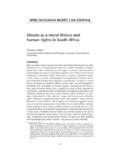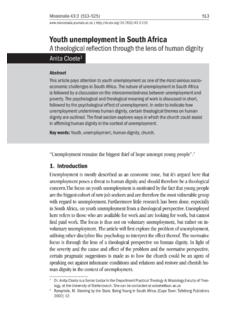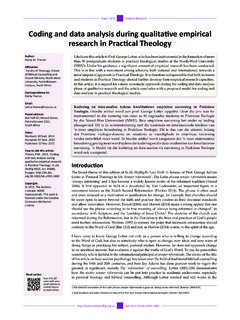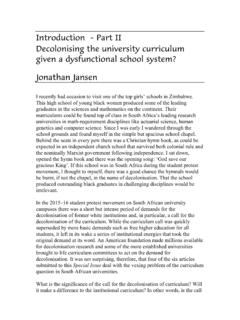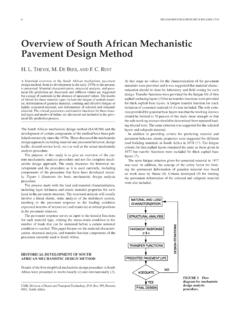Transcription of techNIcAl PAPer benchmarking the Journal of the …
1 Journal of the south african Institution of civil engineering Volume 50 Number 2 June 20082 EMILE HORAK completed his undergraduate studies at the University of Pretoria and his postgraduate studies at the University of Stellenbosch, the School for Business Leadership (University of south Africa, Unisa) and the University of California, Berkeley. He was head of the Department of civil and Biosystems engineering at the University of Pretoria from 1998 to 2007. Before that he was a senior executive at Murray & Roberts Contractors, Roads and Earthworks and Tollcon, executive director of the Roads and Works Division of the Johannesburg City Council, head of service delivery at the Greater Johannesburg Transitional Metropolitan Council, and with Transportek, CSIR where he was actively involved in research and technology transfer.
2 He has published more than 70 papers in international conference proceedings and refereed journals and does specialist consultancy work. Emile is currently a visiting professor at the Council for Scientific and Industrial Research (CSIR) Built Environment during his sabbatical details: Department of civil and Biosystems engineering University of Pretoria T 012-420-2741 PAPerJournal of the south african inStitution of civil engineeringVol 50 No 2, 2008, Pages 2 9, PAPer 652benchmarking the structural condition of flexible pavements with deflection bowl parameters E Horak The falling weight deflectometer (FWD) is used worldwide as an established, valuable, non-destructive road testing device for pavement structural analyses.
3 The FWD is used mostly for rehabilitation project level design investigations and for pavement management system (PMS) monitoring on a network basis. In project level investigations, design charts based on both empirical relations and mechanistic or theoretically based approaches are often used to provide structural evaluations and rehabilitation options. The full mechanistic approach normally uses multi-layer linear elastic theory and back-calculation procedures that have come under scrutiny owing to the inaccuracy of results. A semi-mechanistic, semi-empirical analysis technique has been developed in south Africa in terms of which deflection bowl parameters, measured with the FWD, are used in a relative benchmarking methodology in conjunction with standardised visual survey methodology to give guidance on individual layer strengths and pinpoint rehabilitation needs.
4 This benchmark methodology enables the determination of the relative structural condition of the pavement over length and in depth without the requirement for detailed as-built data. A further correlation study with calculated surface moduli and deflection bowl parameters is presented here for granular base pavements, which can enhance benchmarking : falling weight deflectometer, bowl parameters, benchmarking , surface moduliINtroductIoNThe south african pavement design proce-dure is a mechanistic empirical (ME) proce-dure that utilises basic engineering properties such as the layer elastic modulus, Poisson s ratio, layer thicknesses and loading condi-tions (Jordaan 1988, 1990) as input variables.
5 Assumptions are made regarding the mate-rial-related Poisson s ratios, whereas the layer thicknesses must be determined accurately and elastic moduli can be derived from known ranges of values for specific material types and their behaviour states (Freeme 1983). Material characterisation can also be derived from field and laboratory tests. Measured deflection bowls can be used to undertake back-calculations with linear elastic software to derive the elastic modulus (E-value) of each layer. In essence, the measured deflection bowl is used as reference by changing the E-values of the various pavement layers until the theoretically calculated deflection bowl fits the measured deflection bowl within pre-determined tolerances.
6 The iteration process is started by fixing the E-value of the subgrade that correlates with the outer region of the deflection bowl. Thereafter the layer on top of the subgrade is fixed to fit the deflection bowl of the region closer to the point of loading. By fixing the E-values of the structural layers progressively from the subgrade to the base layer, the deflection bowl is compared with the regions progressively closer to the point of loading (Horak 1988). Standard software such as ELSDEF, IDME, PADAL, MODULUS and ISSEM4 are some of the back-calculating programs developed in the late 1980s and early 1990s that utilised this technique (Horak 1988; Lacante 1992).
7 The pavement layer material type composi-tion and layer thickness relationships of the pavement must be known accurately in order to do a mechanistic analysis of the pavement . Typical pavements in south Africa consist of a rather stiff subgrade, and stabilised layers are often used as sub-base. The base layers may often be cementitious, but are mostly granular and vary in quality from high-quality, freshly crushed rock to natural gravel. Since an in-depth knowledge of pavement materials and their behaviour is needed to perform back-analyses, it is an area of specialist expertise. Worldwide development of back-analysis procedures and associated software took place in the past ten years, but have run into various problems of credibility owing to the uncertainties regarding material characterisa-tion, the uniqueness of measuring equipment, personal interpretations and basic material variabilities (Ullidtz 2005).
8 A semi-mechanistic empirical analysis procedure developed in south Africa utilises Journal of the south african Institution of civil engineering Volume 50 Number 2 June 20083the measured deflection bowl and its cor-relations with the structural layers or zones of the pavement structure (Maree & Jooste 1999). Aspects of this approach have been included in the standard rehabilitation design procedure for flexible pavements, namely the techNIcAl Recommendations for Highways 12 (TRH 12) (CSRA 1997) and subsequent improvements to the procedure. Elastic moduli were back-calculated and surface moduli calculated from a data set of measured deflection bowls also used in an original correlation study (Maree & Bellekens 1991).
9 The two derived pavement structural values were then correlated with these deflection bowl parameters describing zones on the deflection bowl. The results of this correlation study confirmed the soundness of the basis of the benchmarking procedure (Maree & Jooste 1999).In essence deflection bowl parameters can be used in a benchmarking procedure (Horak & Emery 2006) to help identify weaker areas in the pavement over the length and in the depth of the structure to optimise further detailed investigations. The basis for the benchmarking approach is described, demonstrated and enhanced by using sur-face moduli calculations (Horak 2006) and further derivatives.
10 Since these benchmark analyses are based on simple spreadsheet cal-culations using the measured falling weight deflectometer (FWD) deflection bowls, complicated back-analyses using complicated linear elastic layered software or finite ele-ment method analyses are not of the deflectIoN bowl When a flexible pavement deflects under the load of a heavy vehicle, the influence of the load will usually extend over an area 1 m to 2 m away from the point of loading, in three dimensions. This deflected area tends to form a circular, deflected indentation known as a deflection bowl. The size and shape of deflection bowls vary and depend on a number of factors, including pavement composition and structural strength, size of the load contact area, load magnitude, dura-tion of loading, the measuring device used, and temperature (Horak 1987, 1988; Lacante 1992).

